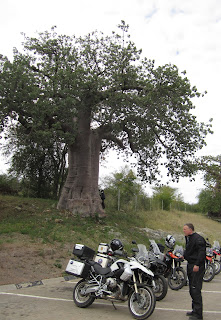Longest, hottest day on the road so far, 637 km of land with few animals and fewer people. The Canadians, Juan and Per decided to add yet another 35 km in order to ride down a dirt road, at the end of which was a large meteor.
Our hotel here features solid walls, and it took me a night or two even to notice the thatched ceiling high above our heads, so used to the material I have become. And there's internet here! Plentiful, free, and no password required.
This little cutie is a steenbok, a tiny antelope about Zucchini size.
The last two days have been filled with long morning and afternoon game drives through the park, which I've been told is the largest national park in the world, and the only one visible from space. Having seen the great salt pan today, my skepticism has vanished.
Yesterday morning, I climbed into the truck with Rob, and nearly as soon as we entered the park, we were surrounded by herds of zebras, springboks, gnus, gemsboks... so many creatures it was nearly impossible to take it in.
Further into the park, the season's lushness (it appears we are in a ten-year flood year) meant that traditional watering holes lost their value as viewing sites, and the wildlife spread out considerably.
Still, the animals rarely gave us more than a passing glance, and we approached so close as to be able to reach out and touch some of them. This, of course, is strictly forbidden, as is getting out of one's vehicle anywhere except at approved safe areas.
Journeys of giraffes last night spanned the horizon, sharing their grazing and browsing lands with zebras, egrets, wildebeests and springboks. Driving down the gravel park roads, we had to be careful to mind the frequent zebras in the road, none of which showed the slightest interest in moving until they were darned good and ready.
This morning, after our visit to the pan, we spotted two rhinos in a distant field. Drawing closer, we trained our binoculars on their noble faces, shocked to find that we were seeing a pair of exquisitely rare black rhinos. These beasts have shorter heads, longer horns, and pointed mouths fit for browsing the leaves off trees. Their cousins, the white rhinos, with their longer, lower set heads and wide, rectangular mouths, subsist by grazing. While a bit more plentiful, they also face ever increasing threat from poachers, interested only in their horns, valued at many thousands of dollars in the Chinese drug market. According to Rob, poaching has reached the horrifying numbers of two rhinos per day currently, making rapid extinction of this rare beast an imminent threat.
Last night, our last night of the trip, the Mokuti staff surprised us with a sundowner, bundling us into a safari vehicle and driving us out to a silent airstrip in the bush. There, we were met with candles, a picnic, and canvas chairs where we sat to take in the vast African sky, full of stars and galaxies and all the miracles of the universe.
Tomorrow we leave to ride to Windhoek, the last day of this trip. While I will be very happy to be home, I will miss Africa. Her raw, majestic reality will stay with me as long as I live.

















